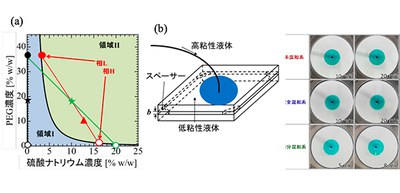
Clarification of viscous fingering dynamics will increase the efficiency of enhanced oil recovery process involving fluid displacement techniques
A group of researchers from Tokyo University of Agriculture and Technology, Indian Institutes of Technology Ropar, and Osaka University has clarified that interfacial deformation occurs in partially miscible systems.
The displacement of one fluid by another in porous media is observed in several processes, such as carbon dioxide (CO2) sequestration. Once the CO2 released from heavy industry has been captured, it is compressed into a liquid state, transported, and stored into depleted oil and gas reservoirs in order to limit climate change. CO2 could also be used for enhanced oil recovery (EOR), where CO2 is injected into oil and gas reservoirs to increase their extraction.
When the displaced fluid is more viscous than the displacing fluid, the interface is hydrodynamically unstable, forming finger-like patterns due to a positive viscosity gradient in the flow direction, which reduces the displacement efficiency.
In contrast, when the displaced fluid is less viscous, the interface is hydrodynamically stable and grows uniformly regardless of whether the binary system is fully miscible or not. In the EOR process, fluids are partially miscible under the reservoir condition at high pressure, but the fingering in partially miscible systems has not been investigated experimentally.
The researchers experimentally changed a solution system from immiscible to fully miscible or partially miscible by varying the salt concentration of the displaced solution in an aqueous two-phase system (ATPS) consisting of polyethylene glycol (PEG), salt (Na2SO4), and water, while leaving the viscosities relatively unchanged at room temperature and atmospheric pressure.
Using the ATPS, they conducted hydrodynamically stable displacement experiments, in which a more-viscous fluid displaced a less-viscous fluid in porous media (Hele–Shaw cells). Hydrodynamically stable interfaces were observed in both the immiscible and fully miscible cases, but a noncircular deformed interface appeared in the partially miscible case.
Within the experimental period, the interfacial tension remained constant with time for the immiscible system and decreased with time for the fully miscible system but increased with time for the partially miscible system. This transient interfacial tension means an increased concentration gradient, indicating that spinodal decomposition occurred when one thermodynamic phase spontaneously separated into two phases.
Previous studies reported the occurrence of spontaneous convection by the Korteweg force, the force produced under spinodal decomposition. In this study, quantitative correlation between the interfacial deformation and a proposed dimensionless number Bf (body force) demonstrated that body force driven by spinodal decomposition induced interfacial deformation. The researchers also clarified the observed fingering was caused by spontaneous convection of the Korteweg force. Theoretical findings qualitatively agreed with experimental results.
This study clarified the influence of partial miscibility on interfacial hydrodynamics and properties of interfacial deformation resulting from partial miscibility. The displacement of one fluid by another in porous media takes place in the processes of EOR and CO2 sequestration. This group’s achievements will contribute to improving the accuracy of predicting fluid displacement.

Figure 1

Figure 2

Figure 3

Figure 4
The article, “Fingering pattern induced by spinodal decomposition in hydrodynamically stable displacement in a partially miscible system” was published in Physical Review Fluids at DOI: https://journals.aps.org/prfluids/abstract/10.1103/PhysRevFluids.4.104005.
